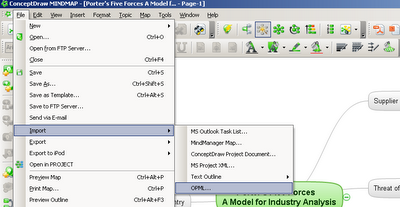Baseball pitchers know all about “Pre Pitch Planning”. They use this technique to carefully plan out each time they are going to throw a baseball. They need to think about how they will hold the ball, the release point, the motion placed on the ball, the velocity at the time of release, the intended destination point, and of course-- the batter.
The same 3P technique can be use when presenting mind maps created from ConceptDraw MINDMAP. ConceptDraw MINDMAP is a great tool for creating informal presentations or when you what to interact with the group you are presenting to.
I have built a small map that is located at MindMapPedia.com: http://www.mindmappedia.com/?id=214646313. You can easily download this mind map to see how you can configure some of the items discussed in this posting. Keep in mind, this post is focused on how to present using ConceptDraw MINDMAP.
Here is a list of some of the things you want to take into consideration when you present your mind map.
- Not everyone is familiar with how to read a mind map. Knowing this, I like to have my main idea left aligned and all the topics aligned to the right.
- Ensure the default font is big enough at each level being presented, so it is legible to your audience.
- Adjust your background color and topic colors to match your team or company style.
- Ensure “Auto Arrangement” is on, and if you want to eliminate the distraction of the menu, press F5 (this toggles full screen mode on and off)

Auto Arrange toggled on
- To present press the plus symbol to fold out a branch for display. When you are ready to move to the next branch, you collapse the branch you are viewing, using the minus symbol
- If you fold all of the subtopics out, when you open the branch they are attached and will be revealed at the same time.
- If the subtopics are folded in, when you open the branch, they will be revealed one at a time.
- For easy and rapid zooming on any topic or group of topics in your map, just rubber band the topics you want to view by holding briefly, and the objects will automatically zoom. http://www.blogger.com/video-play.mp4?contentId=53a4f85011dd66bf&type=video%2Fmp4
ConceptDraw zoom demonstration
- When you want to return to normal size, release the mouse and the map is restored to the previous view.
It is easy to present your map, but like baseball, you should always practice before you go in front of a live audience.
There are two other features contained in ConceptDraw MINDMAP that can come into play here and that is templates and themes. In the next few future postings I will delve into templates, because they are great tools with the potential to save you time. Templates can contain both a theme and information. A template has many uses.


 Start to Start
Start to Start Finish to Finish
Finish to Finish Finish to Start
Finish to Start  Start to Finish
Start to Finish






